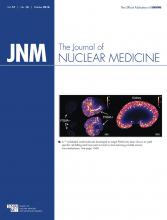Molecular imaging in immunotherapy: Ehlerding and colleagues outline current applications of noninvasive techniques for preclinical imaging of immunotherapy targets and suggest future pathways for molecular imaging in this developing field.
Page 1487
New theranostic paradigm for DTC: Pattison and colleagues review the current role of molecular imaging in differentiated thyroid cancer and preview an article in this issue of JNM incorporating somatostatin receptor imaging in this setting.
Page 1493
PET renal GFR: Blaufox assesses the promise and challenges of nuclear medicine techniques in renal function evaluation and previews an article in this issue of JNM using a PET agent to measure glomerular filtration rates.
Page 1495
Reverse translation: Albin and Frey look at the potential of studies that “reverse” conventional scientific workflow by assessing clinical results in preclinical models and preview a related article in this issue of JNM focusing on biomarkers in Parkinson disease.
Page 1497
PET/CT and response in DTC: Jentzen and colleagues analyze pretherapy and follow-up 124I PET/CT data on bone metastases from differentiated thyroid cancer patients to assess relationships between absorbed radiation dose with and response after initial radioiodine treatment.
Page 1499
Pretargeted immuno-PET in MTC: Bodet-Milin and colleagues report on optimized molar doses and pretargeting intervals of an anticarcinoembryonic antigen bispecific antibody and 68Ga-labeled IMP288 for immuno-PET in relapsed medullary thyroid carcinoma.
Page 1505
SSTR PET/CT in DTC: Binse and colleagues evaluate the impact of 68Ga-DOTATOC PET/CT in detecting recurrence or metastases in patients with differentiated thyroid carcinoma and elevated serum thyroglobulin with negative radioiodine and 18F-FDG PET/CT results.
Page 1512
Breast parenchymal uptake on PET/CT: Leithner and colleagues quantitatively assess breast parenchymal uptake on 18F-FDG PET/CT as an imaging biomarker and examine its correlation with background parenchymal enhancement, amount of fibroglandular tissue, and age.
Page 1518
HER2+ PET in HER2− breast cancer: Ulaner and colleagues determine whether imaging with a human epidermal growth factor receptor 2–targeted PET tracer can detect HER2-positive metastases in patients with HER2-negative primary breast cancer.
Page 1523
Simplified quantification of 18F-FE-PE2I: Sonni and colleagues identify the optimal acquisition time window for this new dopamine transporter PET radioligand and validate the specific binding ratio as a simplified quantification method in Parkinson disease.
Page 1529
18F-AV-1451 tracer kinetics: Shcherbinin and colleagues report on kinetic modeling results for dynamic acquisition data with this PET tau tracer in cognitively normal individuals and individuals with mild cognitive impairment and Alzheimer disease.
Page 1535
Parametric imaging of 18F-DPA-714: Golla and colleagues identify the best method for generating quantitative parametric images of binding for this PET radioligand for the 18-kDa translocator protein.
Page 1543
Real-time microfluidic radioassay: Liu and colleagues describe a continuously infused microfluidic radioassay system for real-time in-culture measurement of cellular uptake, with initial tests on the influence of cellular glucose concentration on 18F-FDG uptake kinetics.
Page 1548
PET in myelofibrosis: Derlin and colleagues assess the feasibility of 18F-FDG PET/CT for noninvasive monitoring of treatment response after allogeneic stem cell transplantation in patients with myelofibrosis.
Page 1556
Radionuclide evaluation of brain death: Zuckier provides an educational overview of the evolution of scintigraphy in brain death, current clinical and imaging practice guidelines, limitations, and potential future expanded roles.
Page 1560
211At-6 for PSMA-targeted α-therapy: Kiess and colleagues report on preclinical results with a urea-based, 211At-labeled small molecule–targeting prostate-specific membrane antigen in mice bearing prostate cancer micrometastases.
Page 1569
Vascular-targeted radioimmunotherapy: Behling and colleagues investigate antibody targeting of the vascular endothelium of glioblastoma with cytotoxic short-range, high-energy α-particles in a clinically relevant transgenic glioblastoma mouse model.
Page 1576
Dual-activity vascular inflammation imaging: Withana and colleagues report on activity-based probes targeting cysteine cathepsins that can be used in murine models of atherosclerosis to noninvasively image activated macrophage populations with both optical and PET/CT methods.
Page 1583
Brain network activity and cell implantation: Peng and colleagues use PET to examine changes in brain network activity caused by striatal implantation of human levodopa-producing retinal pigment epithelial cells in parkinsonian macaques.
Page 1591
18F-MK-6240 and NFTs: Hostetler and colleagues describe preclinical characterization of this PET tracer targeting the neurofibrillary tangles associated with Alzheimer disease.
Page 1599
CD3 PET and immune therapy response: Larimer and colleagues examine the potential of 89Zr-labeled, T-cell–targeting PET as a predictive marker in a murine model of colon cancer immunotherapy.
Page 1607
Imaging AT1R-specific binding: Hachem and colleagues assess the binding profile of 18F-FPyKYNE-losartan, a novel PET agent for imaging the angiotensin type 1 receptor.
Page 1612
Specific activity in integrin PET: Notni and colleagues investigate the influence of specific activities of 68Ga-aquibeprin and 68Ga-avebetrin tracers for selective in vivo PET mapping of integrins α5β1 and αvβ3, respectively.
Page 1618
18F-fluorodeoxysorbitol renal PET: Wakabayashi and colleagues test in rats the feasibility of renal PET imaging with this analog of sorbitol that is freely filtered at the renal glomerulus without reabsorption at the tubule.
Page 1625
Cystine knot peptide photoacoustic imaging: Zhang and colleagues report on development and evaluation of a dye-labeled cystine knot peptide that selectively recognizes integrin αvβ6 with high affinity for photoacoustic and fluorescence imaging.
Page 1629
CT prediction from MR images: Wu and colleagues present a patch-based method for CT prediction from MR images, generating attenuation maps for PET reconstruction requiring no image segmentation or registration.
Page 1635
PVE correction in oncologic PET/CT: Cysouw and colleagues explore the effect of partial-volume correction combined with several volume-of-interest methods on the accuracy and precision of quantitative PET.
Page 1642
Fluorescence camera navigation: KleinJan and colleagues evaluate the feasibility of a nuclear medicine–based navigation concept that allows intraoperative positioning of a fluorescence camera in the vicinity of preoperatively defined sentinel nodes containing indocyanine green–99mTc-nanocolloid.
Page 1650
ASNC/SNMMI on PET MPI: Bateman and a collaborative team of experts from the American Society of Nuclear Cardiology and SNMMI release a joint position statement on clinical indications for PET myocardial perfusion imaging.
Page 1654
- © 2016 by the Society of Nuclear Medicine and Molecular Imaging, Inc.







